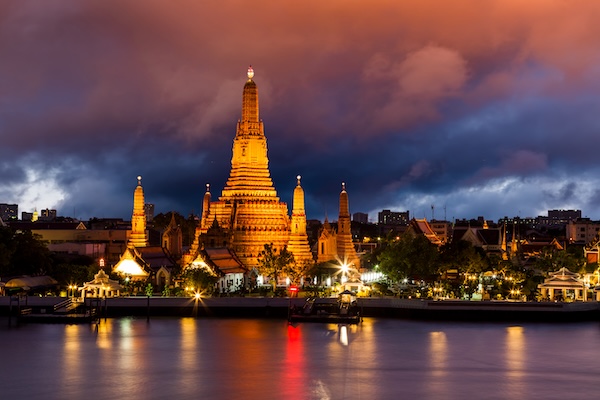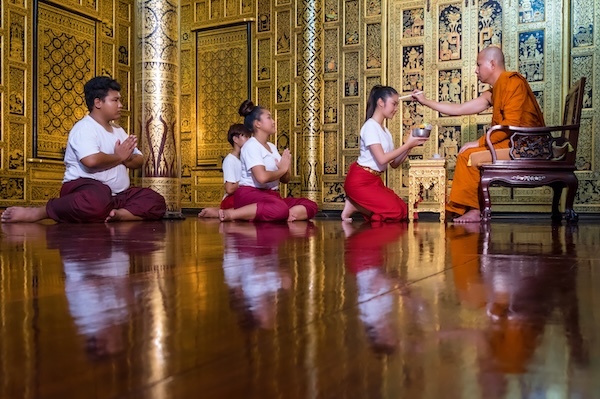Experience the soul of Thailand through Visakha Bucha, a sacred celebration of light, compassion, and spiritual awakening. Here’s everything you need to know about this meaningful festival in 2025.
Visakha Bucha in Thailand: A Journey into the Country’s Spiritual Heart

When the Full Moon Calls for Reflection
Visakha Bucha in Thailand is one of the most powerful celebrations where spirituality lights up temples across the country.
As the sixth lunar month reaches its peak, Thailand’s temples shimmer under a gentle, sacred glow.
Visakha Bucha invites the nation — and visitors — into a rare moment of collective stillness. It’s more than a holiday; it’s a call to reconnect with something timeless: the Buddha’s journey from birth to enlightenment and ultimate liberation.
Curious about how this sacred event ties into global traditions?
See this article about Buddha’s Birthday for a broader perspective.
Why “Visakha”?
The name “Visakha” traces back to ancient languages, evoking a time of blossoming wisdom and renewal under the glowing full moon — a symbol of spiritual maturity in many cultures.
A Brief History of Visakha Bucha in Thailand
The roots of Visakha Bucha trace back to ancient India, where early Buddhist communities commemorated the Buddha’s birth, enlightenment, and passing on the same full moon day of the lunar month Vaisakha. These three pivotal moments were seen as a cosmic convergence worthy of deep reverence.
In Thailand, records suggest the celebration was formally introduced during the Sukhothai era (13th–15th century), when Theravāda Buddhism became the kingdom’s spiritual foundation. Kings and monks institutionalized the festival to strengthen the moral compass of the people and align society with Buddhist ethics.
Later, during the Ayutthaya and Rattanakosin periods, royal courts expanded Visakha Bucha with formal rituals, processions, and nationwide observances. In 1957, it was officially declared a public holiday across Thailand.
One little-known anecdote: during the reign of King Rama IV (Mongkut), a monk-turned-king deeply committed to science and spirituality, Visakha Bucha processions were timed with astronomical precision — blending Buddhist faith with the study of the stars.
Timeline of Visakha Bucha
- 6th century BCE – Estimated date of the Buddha’s birth, enlightenment, and passing.
- 13th century – Visakha Bucha introduced to Thailand during the Sukhothai Kingdom.
- 19th century – King Rama IV aligns processions with lunar astronomy for precision.
- 1957 – Declared a public holiday nationwide under the Thai government.
- 1999 – United Nations proclaims Vesak Day an International Observance.
From Ancient Monasteries to Modern Global Recognition
Long ago, pilgrims from Sri Lanka carried these sacred traditions into Thailand, where kings and monks wove them into the national soul. Today, thanks to a United Nations resolution in 1999, Vesak is celebrated worldwide, honoring Buddha’s universal message of peace and compassion.
Across Borders, One Common Prayer
Whether walking barefoot around Angkor’s ruins or meditating beside the Bodhi Tree in India, Buddhists everywhere offer the same silent prayer: may all beings find peace and freedom.
When Thailand Glows: Visakha Bucha 2025
Date to Mark
In 2025, Visakha Bucha in Thailand will once again transform the country into a landscape of peaceful rituals and candlelit ceremonies.
The festival falls on May 11, 2025.
Unlike fixed-date holidays, it follows the ancient lunar calendar — linking celebrations not to a number, but to the moon’s soft silver crown.
Curious about how Thailand’s festivals align with the moon?
Read our guide to the Thai calendar.
A Pause Across the Nation
On Visakha Bucha, daily life slows down.
Shops close early, bars fall silent, and the buzz of traffic softens. It’s a day to step away from the rush — and step inward instead.
Traditions That Light the Soul

Morning Offerings: Acts of Devotion
At sunrise, locals dressed in white gather at temples, their hands cradling baskets of rice, fruit, incense, and flowers.
Each offering, humble yet powerful, echoes the Thai belief in merit, gratitude, and the enduring cycle of generosity.
Wian Tian: A Sea of Light
As dusk settles, temple courtyards transform.
Thousands of candles flicker as worshippers walk three silent circles around the main hall, cradling flames that dance in the night air — a living symbol of inner awakening.
Love candlelit ceremonies?
Explore the spectacular Candle Festival of Ubon Ratchathani for another breathtaking experience.
Local Rituals and Kind Deeds
In Chiang Mai, pilgrims climb Doi Suthep under the moon’s watchful gaze, their footsteps echoing centuries of devotion.
In towns and villages, families release birds and fish, symbolic gestures of setting life free — and of freeing themselves from attachment.
Charity takes center stage too, with food drives and donations multiplying across the country.
Each year in Chiang Mai, on the eve of Visakha Bucha, local youth groups and university students gather at the base of Doi Suthep to rehearse the long candlelit walk up to the temple. Elders share traditional chants and breathing techniques passed down for generations. For many, this nighttime pilgrimage is not just a ritual — it marks a rite of passage into adulthood and community service.
Respecting the Sacred Atmosphere
In honor of the day’s spiritual focus, the sale of alcohol is banned throughout Thailand — from bustling Bangkok to the smallest village markets.
Week-Long Celebrations
Leading up to Visakha Bucha, cities host exhibitions, Buddhist lectures, theatrical performances, and serene spiritual fairs, inviting everyone to dive deeper into Thailand’s cultural soul.
The Royal Family’s Sacred Tribute
At Bangkok’s revered Wat Phra Kaew, members of the Thai Royal Family gather to pay homage — a vivid reminder of the profound link between Buddhism and the monarchy.
Embodying the Eternal Teachings
Living the Five Precepts
Visakha Bucha isn’t just about attending ceremonies; it’s an invitation to embody five timeless principles: kindness, honesty, respect, mindfulness, and moderation.
A simple yet powerful roadmap to a better self — and a better world.
The Silence of Meditation
Inside shaded temple halls, devotees sit in stillness, breathing slowly, letting compassion swell quietly within.
In a world rushing toward noise, Visakha Bucha reminds us: true strength often lies in quiet simplicity.
Experiencing Visakha Bucha: A Visitor’s Guide
Participating with Grace
Visitors are warmly welcome — but respect is essential.
Dress in white or modest colors, cover shoulders and knees, remove shoes before entering temples, and approach each ritual with humility and openness.
Where to Witness the Magic
- Wat Phra Kaew (Bangkok): Thailand’s spiritual epicenter, home to the sacred Emerald Buddha.
- Wat Phra That Doi Suthep (Chiang Mai): A mystical ascent crowned by breathtaking views and solemn rituals.
- Phutthamonthon (Nakhon Pathom): A vast park designed for mass meditation and celebration.
Practical Tips for Attending Visakha Bucha in Thailand
Best Time to Attend Ceremonies
Ceremonies typically start at dawn for the morning offerings and resume at dusk for the candlelight processions. Arriving early—around 6 AM or 5 PM—ensures a better spot and a more immersive experience, especially at major temples.
Managing Crowds at Major Temples
Expect large crowds at iconic locations such as Wat Phra Kaew in Bangkok and Wat Phra That Doi Suthep in Chiang Mai. Arrive at least an hour early for candlelight processions, and follow instructions from temple staff or volunteers for a smooth experience.
Transportation and Accommodation
While public transport operates normally, streets near major temples may close temporarily for ceremonies. Book accommodations close to main temple areas early to avoid last-minute price surges.
Dress Code and Behavior
Wear white or light-colored modest clothing. Ensure your shoulders and knees are covered, and remove your shoes before entering any temple buildings. Maintain a respectful demeanor throughout the ceremonies.
Regional Variations in Visakha Bucha Celebrations
| Location | Highlights |
|---|---|
| Bangkok (Wat Phra Kaew) | Grand ceremonies with royal attendance, large candlelit processions, and highly formal atmospheres. |
| Chiang Mai (Doi Suthep) | Nighttime pilgrimages up the mountain with thousands of candles lighting the path to the temple. |
| Ayutthaya | Solemn ceremonies amidst the ancient temple ruins, offering a historic and atmospheric experience. |
| Nakhon Pathom (Phutthamonthon) | Mass meditation gatherings in a large Buddhist park designed for public ceremonies. |
Modern and Interfaith Dimensions of Visakha Bucha
While Visakha Bucha remains a deeply Buddhist celebration, it increasingly welcomes non-Buddhists who join out of respect, curiosity, or a shared love for peace and mindfulness. Many ceremonies now incorporate environmental messages and calls for global compassion, making the event feel timeless yet relevant to today’s world.
Food and Customs During Visakha Bucha
During Visakha Bucha week, many Thais practice temporary vegetarianism as a sign of purity and non-violence. Traditional temple foods, fresh fruits, and desserts like Khanom Tom (sweet coconut rice balls) and Kanom Krok (grilled coconut pancakes) are commonly offered and enjoyed during the festivities.
Frequently Asked Questions about Visakha Bucha
Can visitors take photos during Visakha Bucha ceremonies?
Photography is usually permitted, but visitors should be discreet. Avoid using flash, and never take intrusive photos of monks or worshippers during prayers.
Are children welcome at Visakha Bucha events?
Absolutely. Children are often encouraged to participate alongside their families. It’s a wonderful way to introduce them to Thai culture and spiritual practices.
Are there any restrictions during Visakha Bucha?
Besides the nationwide alcohol ban, entertainment venues often limit operations to respect the solemnity of the day. Loud festivities and parties are generally discouraged.
Conclusion

In Thailand, Visakha Bucha is not just observed — it’s lived.
Through candlelight, whispered prayers, small acts of kindness, and moments of inner stillness, it draws a luminous map back to peace.
Step into it, even for a moment, and you may find yourself changed.
🔄 Last updated on April 29, 2025
